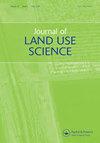在乌拉圭,从受管理的草原到农田的土地利用转换增加了向大气的中期净碳排放
IF 3.3
4区 环境科学与生态学
Q1 AGRICULTURE, MULTIDISCIPLINARY
引用次数: 1
摘要
摘要在全球范围内,传统管理的温带草原向农田的土地转换正在发生。其中包括乌拉圭中南部,近几十年来的变化极有可能在区域范围内影响植物生产力、土壤质量和碳通量。开发并验证了生物物理模型EPIC的地理空间版本(geospatial EPIC UY)。对土地利用变化对碳通量的潜在影响进行了分析,考虑了15年内所有合适种植区的转换。模拟的净生态系统交换(NEE)表明,平均而言,草原碳排放量接近中性(0.1 Mg CO2 ha−1 year−1),而农田的贡献几乎是这个值的7倍。草地NEE的年际变化显著小于农田。这些结果突出了延长土地转换下的潜在碳损失,如果实施最佳管理实践,这种损失可能会减弱甚至恢复。本文章由计算机程序翻译,如有差异,请以英文原文为准。
Land-use conversions from managed grasslands to croplands in Uruguay increase medium-term net carbon emissions to the atmosphere
ABSTRACT Globally, significant land conversions of traditionally managed temperate grasslands to croplands were taking place. Among these is South-Central Uruguay where changes in recent decades have highly likely impacted plant productivity, soil quality, and carbon fluxes at a regional scale. A geospatial version of the biophysical model EPIC was developed and validated (Geospatial-EPIC-UY). An analysis of the potential impact of the land use change on the carbon fluxes was performed, considering the conversion of all the suitable cropping areas over a 15-year period. Modeled net ecosystem exchange (NEE) showed that, on average, grasslands C emissions were close to neutral (0.1 Mg CO2 ha−1 year−1), while croplands contributed almost 7 times this value. Also, the inter-annual variation of grassland NEE was significantly less than that of the cropland. These results highlight the potential C losses under extended land conversions, which could be attenuated or even reverted if best management practices were implemented.
求助全文
通过发布文献求助,成功后即可免费获取论文全文。
去求助
来源期刊

Journal of Land Use Science
Environmental Science-Management, Monitoring, Policy and Law
CiteScore
5.40
自引率
6.20%
发文量
26
期刊介绍:
The Journal of Land Use Science provides a central outlet for high-quality articles on theoretical and empirical aspects of land-use science at the interface of social and environmental systems. The Journal brings together an array of research perspectives at multiple temporal, spatial and social scales that contribute a better understanding of land-system dynamics and communicate scientific advances towards attaining land-system sustainability.
 求助内容:
求助内容: 应助结果提醒方式:
应助结果提醒方式:


